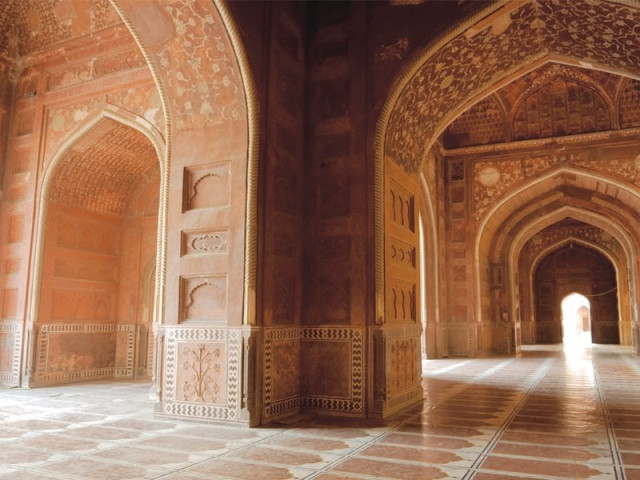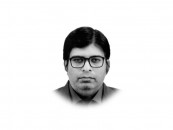A glimpse of the magnificent Mughals
From Babar’s Bagh-e-Wafa to Zafar’s defeated golden crown, Mughal exhibit brings to life journey of legendary empire.

From Babar’s Bagh-e-Wafa to Bahadur Shah Zafar’s defeated golden crown, the Mughal exhibit brings to life the journey of a legendary empire.
Exhilaratingly, it turns out to be a spectacular treasure trove of imperial life, unearthed by curator Malini Roy, from the vaults of the British Library. The knowledge of Mughals that exists around the edges of one’s memory comes to life in the exhibit, pulsating tangibly with the excellence and the grandeur of the legendary empire. The poets, scholars, statesmen, warriors and kings that the Mughals were, is highlighted beautifully as the exhibit unfolds through three centuries of achievements in architecture, literature, astronomy, science and the unparalleled patronage of the arts.
Descendants of Genghis Khan and Timur, the Mughals ruled over South Asia from 1526 to 1858. At its peak, the empire encompassed most of present day India, Pakistan, Bangladesh and eastern Afghanistan. Babar, a Central Asian prince, conquered Kabul, Lahore and ultimately Delhi in 1526. He became the first of 15 Mughal emperors followed by Humayun, Akbar, Jahangir, Shah Jahan and Aurangzeb Alamgir, who are collectively known as the ‘Great Mughals.’ The gradual decline of the empire began when the later Mughal emperors began to face consecutive wars of succession as well as multiple invasions, and struggled to maintain control of a diminishing empire.
The Mughals were highly cultured and cultivated a sophisticated lifestyle based on both the Iranian and Indian examples. Architecture flourished under their patronage; they commissioned fortresses, palaces, mosques and mausoleums as a representation of their powerful stature. One of the greatest accomplishments of the Mughals was to initiate a new tradition of painting. Court historian Abu’l Fazl documented Akbar’s interest with these words: “His Majesty from his earliest youth has shown a great predilection for this art and gives it every encouragement. Hence the art flourishes and many painters have obtained great reputation.” Akbar’s Tasveer Khana was led by eminent Iranian artists and employed more than 100 Hindu and Muslim artists of various skills, for projects that included Hamzanama, story of Ameer Hamza, which took 15 years to complete. Akbar encouraged artists to follow a realistic depiction of subjects, drawing attention to the individual’s features and physiognomy. Many painters and calligraphers collaborated to create manuscripts primarily for the emperor’s private library. The works of miniature painters are riveting representations of their skill and excellence.
The Mughals were keen patrons of literature and Babar himself was a poet and a diarist. A painting depicting one of Babar’s gardens, Bagh-e-Wafa in Kabul in 1504, hangs alongside a detached folio from Babarnama (Memoirs of Babar), where he lovingly describes the details of the garden and the nights he spent there. Turkish Chaghatay was the original language of the Mughals but the literary language was Persian, which was also the preferred language for those who sought a position of influence. Shown here is the outstanding, 17th century, Turkish-Persian dictionary. Commissioned by Akbar, it was arguably the most important Persian dictionary till the end of the 19th century.
Great bibliophiles, the Mughals loved the traditions of fine arts and works of Iranian and central Asian masters. There were 24,000 volumes in Akbar’s library at the time of his death. A folio from “Shahnama” (the book of kings) remains from many books that were looted or given away in later years. Hamida Bano Begum, Akbar’s mother was one of the few Mughal women who had a library of her own. A late 16th century volume of Diwan-e-Hijri from her collection can be seen here. As are Shah Jahan’s books such as “Kabutarnama” — a treatise on the art of keeping pigeons. “The Notebook of Fragrance” dated 1698 is an interesting manuscript intended for gentlemen, containing formulae for perfumes and soaps, techniques for arranging a house, a garden or a library and for igniting fireworks.
Sciences were actively cultivated and significant advances were made in many fields by combining Indian and Islamic scientific traditions. Humayun had his own observatory where astronomical observations were recorded in tables and treatises. Geography, cartography and gazetteers were vital both for administrative purposes and for data used in compiling astronomical tables and calculating prayer times. Mughal physicians produced detailed medical manuals, some of which are on display. They were aware of the ancient Ayurvedic and contemporary European medicine but were greatly influenced by Unani Greco-Arabic tradition, which still flourishes in India and Pakistan today.
The Mughals ruled a vast empire, accommodating the culture and religion of the diverse peoples inhabiting the land. Peace and harmony of the empire depended on maintaining a balance between the Hindu majority and the Muslim, Christian, Zoroastrian, Jain and Sikh population. The tolerance of the Mughal emperors is a part of their legacy. Depicted in the exhibition are also Akbar’s efforts to hold inter-faith debates, his appointment of Hindu ministers and encouragement of multi-faith marriages and finally, his formation of Din-e-Elahi, a religion of his own, albeit controversial, which combined the features of various faiths.
The exhibit also brings out Aurangzeb’s commitment to religion and Shariah during his reign, symbolised by al-Fatawa Alamgiria, a vast compendium of Islamic jurisprudence in Arabic which took 50 Islamic scholars eight years to complete. The displayed copy originally belonged to Sir William Jones, judge of the Supreme Court in Calcutta.

Presented alongside is Dara Shikoh, a depiction of the diversity of religious thought among the Mughals. Interested in the Sufi, mystical aspect of Islam, Dara Shikoh tried to reconcile Islamic and Hindu doctrines. Also on display at the exhibition is his last work, the translation of the Upanishads, a philosophical thesis of Hinduism, which he called Sirr-i-Akber. It was completed in 1657 and it was through this Persian version rather than the Sanskrit one that the Upanishads reached the West.
There is also a glorious display of the early 19th century collection of exquisitely artistic and calligraphic copies of the Quran, with Persian translation.
In a lit glass case sits the last emperor Bahadur Shah Zafar’s gold crown, set with rubies, turquoise and pearls in floral patterns and arches decorated in gold filigree. Many of the artefacts were acquired from various auctions by Robert Tytler, with the gold crown being sold ultimately to Queen Victoria in 1861. Tytler, an officer of the Bengal Army and an ardent photographer, is known for capturing the famous last photograph of Bahadur Shah Zafar II — a bleak, melancholic image of defeat and ruin. The emperor stares at the camera with vacant eyes, while he awaits trial at Delhi’s Red Fort — reduced to an object of curiosity for European residents, who visited him frequently. This black and white image along with others of the Crystal throne, the Friday Mosque and derelict Delhi are symbolic of the decline of the dynasty. Their inherent greyness is in sharp contrast to the opulence and jewel tones of the illustrations of the lives of the Great Mughals at their peak.

By the end of the exhibit, one has viewed 200 pieces, 20 of which are not part of the Library’s own collection. And just within the span of an hour, we have witnessed an enthralling journey of the empire, from the heights of power to a gradual and tragic decline.
Published in The Express Tribune, Sunday Magazine, March 3rd, 2013.
Like Express Tribune Magazine on Facebook to stay informed and join the conversation.



















COMMENTS
Comments are moderated and generally will be posted if they are on-topic and not abusive.
For more information, please see our Comments FAQ